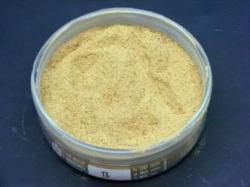Dec 14 2010
AIJU has developed a new plastic compound made with natural dry biomass, specifically the almond shell, for industrial purposes.
The result is a compound material with a wooden appearance and new properties which have been analyzed in-depth.
 Sifted Almond Shell Powder
Sifted Almond Shell Powder
This new material provides other eco-efficient alternatives which reduce the plastic content, derived from non-renewable sources, and at the time give value to this natural waste which is produced in great quantities in Mediterranean countries, and whose only other use is for incineration purposes.
A complete characterization of this material has been done in the study with distinct quantities of almond shell powder, determining the influence of this content on the physical, mechanical, thermal and rheological properties of these formulations.
“The almond shell is a natural waste which is valid for reinforcing common plastic materials. A material with a wood-like appearance is obtained and in general the material has better properties than the non-reinforced plastic material,” explains Suny Martínez responsible for the Material Area at AIJU. “The tensile, bending, hardness, density and temperature resistances increase in reference to polyethylene without the additive. The viscosity at non-elevated temperatures increases as well.”
The obtained formulations can be transformed by injection processes in a similar way to non-compound materials, although the pellets must go through a drying process to eliminate the absorbed moisture in the shell before the transformation, and the temperature must not exceed 220ºC in the process to avoid the almond shell decomposition.
In parallel, AUJU is developing a new material with almond shell for transformation in Rapid Manufacturing processes. Test specimens, in a halter shape, have been successfully sinterized for their characterization, and the enhancement of the recycling characteristics are being worked on as they lose properties and must be rejected after several uses in the process without being sinterized.
These tasks have been carried out within the frame of the IBE-RM Project, partially funded by MICINN and the EU with FEDER resources (Expedient PSE-020000-2009-001) and MatSinter funded by IMPIVA (Expedients IMIDIC/2009/80 y IMIDIC/2010/45). Additionally, we would like to thank the Cooperative “la Trencaora” from Castalla for providing the almond shell.